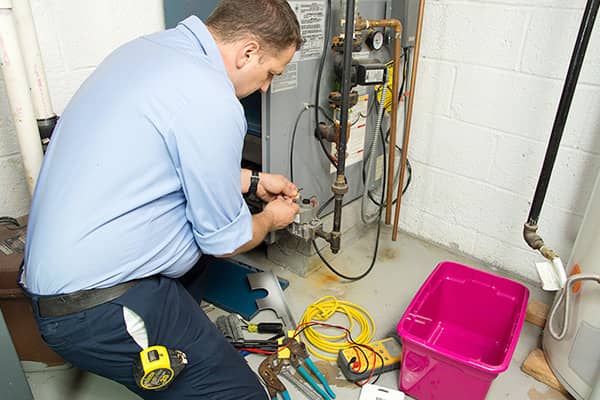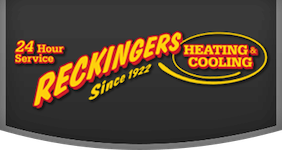Expert Furnace Installations in Dearborn and SE Michigan
A gas furnace is one of the most common and efficient ways for heating your home. Throughout our area of service – Southeast Michigan and the larger Metro Detroit area, the large majority of homes and businesses use gas furnaces for interior heating. If natural gas is available in the area, using a gas furnace as a heating source is the most convenient and efficient option.

Why Install a Gas Furnace in Your Home?
While we offer boiler and heat pump options, gas furnaces are often the best choice our customer’s homes. Here are some advantages of gas furnaces:
- Gas furnaces offer an equal distribution of the heat throughout the house and provide a healthy environment. As gas furnaces are located in basements or other auxiliary spaces in the house, and not in the main living area, residents are protected from gas-related incidents. Also, modern gas furnaces come with sophisticated air filtering systems, keeping dust, pollen and allergens away.
- Gas furnaces are very efficient. The efficiency is measured by the Annual Fuel Utilization Efficiency (AFUE), which is the ratio of annual heat output compared to the total energy used by the furnace. High-efficiency gas furnaces available today offer 90% to 98% AFUE, and low or average efficiency ones have a minimum AFUE rating of at least 80%. Although electric furnaces offer higher APUE, the cost of electric energy throughout the area is usually much higher than the cost of natural gas, which makes gas furnaces a more economical choice.
- Gas furnaces are an investment that pays off in the long term. They are durable and, with proper service and maintenance, will last for decades. High-efficiency gas furnaces will save on utility bills immediately, while also increasing the value of your home.
- Modern gas furnaces work with programmable thermostats to allow selecting for the selection of different temperatures at different periods of the day, helping optimize energy consumption and comfort.
What Type of Gas Furnace is Right for My Home?
Heating experts at the Trane Home Comfort Institute explain that all gas furnaces consist of four main components: burners where the gas is delivered and burned; heat exchangers that transfer the heat from the burners to the home’s air distribution system; a blower that moves the heated air through the ducts and into the home; and a flue that exhausts the gaseous byproducts of combustion to the outdoors.
The four components form the basis of the three most common types of gas furnaces: conventional, induced draft, and condensing.
Conventional furnaces burn natural or propane gas to provide heat to the heat exchanger. Indoor air flows around the heat exchanger to be heated and then circulated throughout the house through the ducts. Additional air is drawn into the flue for venting purposes. This air mixes with the hot exhaust gases and exits through the chimney.
Induced draft furnaces are similar to conventional furnaces except for their venting method. Conventional furnaces draw air through an opening in the front of the furnace and at the flue to create a natural draft. Induced draft furnaces use a fan to draw the combustion products through the heat exchangers and then into the flue. This artificially created draft increases the efficiency of the furnace.
Condensing furnaces contain a second heat exchanger that collects heat from the hot flue gases, yielding additional heat for the home. Because the resulting flue gases are at a very low temperature, they can be vented directly outdoors through a plastic pipe that can run through a side wall. Condensing furnaces are the most efficient on the market.
Now that you know the different types of furnaces, use these tips to for picking the right furnace for your home or business.
There are a few rules for choosing the right type of gas furnace. The most important things you need to check are the capacity of the furnace, AFUE and the brand.
- The right size: The capacity of the furnace has to be proportioned to the size of your home or business, to obtain the best cost/efficiency ratio.
- The right features: The furnace you select should have the right features to both create comfort and increase energy savings. Some of the features available with modern gas furnaces include zoned heating, filtration system, variable heat output, variable speed blower, dual heat exchanger and more.
- The right brand: There are many furnace brands available to choose from. Some provide better efficiency, some better price points, other are longer-lasting. At Reckingers, based on our long experience of servicing and working with all major brands of furnaces, we found the Trane brand to be best suited for the majority of our clients’ needs. Trane furnaces are solidly built, long-lasting and require less maintenance than other brands.
- The right efficiency: The annual fuel utilization efficiency (AFUE) rating is one of the most important considerations when shopping around for a new gas furnace. A gas furnace with a high AFUE ratio will be more efficient and translate into significant savings on the home energy costs over the long term.
- The right cost: Homeowners should consider not just the price of the furnace, but the cost of installation which can vary a lot between different brands and models, and also the cost of the annual maintenance. Also to be considered are the energy savings resulting from increased efficiency and the extra features the new furnace will provide (zoned heating, digital thermostat, etc.)
Still not sure which furnace is right for you? Don’t hesitate to Contact Reckingers Heating & Cooling HVAC specialists today to help you determine the best new furnace for your budget and needs.
